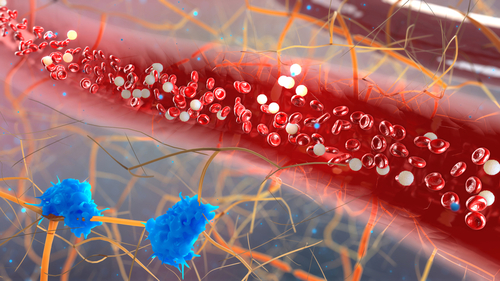Levels of Pro-inflammatory Molecule Can Predict Poor Outcomes in AAV, Study Finds

Patients with ANCA-associated vasculitis (AAV) with elevated SDMA — a pro-inflammatory molecule — in their blood have a greater risk of kidney failure or death, according to researchers.
Their research, “Higher levels of SDMA and not ADMA are associated with poorer survival of trial patients with systemic ANCA-associated vasculitis,” appeared in the European Journal of Rheumatology.
ADMA, a naturally occurring product of the metabolism of L-arginine (an amino acid) in the blood, inhibits the enzyme nitric oxide synthase (NOS), which mediates the production of nitric oxide — a key molecule in the cardiovascular system.
Preclinical work showed that ADMA contributes to abnormal blood vessel cells, blood vessel tightening, elevation of blood pressure, and aggravation of atherosclerosis. ADMA is a marker of mortality in ambulatory patients with peripheral vascular disease and predicts cardiovascular risk.
SDMA, which is ADMA’s stereoisomer — a molecule with the same constitution but different 3D arrangement — does not inhibit NOS. Besides being involved in kidney function, more recent work has shown it has pro-inflammatory properties and reduces nitric oxide availability in blood vessel cells.
SDMA outperformed ADMA involvement as a predictor of cardiovascular complications in some studies. It also has been linked to non-cardiac mortality in patients with stable coronary heart disease and stroke.
The scientists hypothesized that ADMA and SDMA levels may predict cardiovascular risk, all-cause mortality, and kidney function in patients with systemic AAV undergoing well-defined treatment regimens.
Treatment consisted of induction with cyclophosphamide with or without plasma exchange — a procedure that separates and removes plasma, followed by infusion of the other blood components along with a replacement fluid — or low-dose methotrexate, plus glucocorticoids.
Maintenance treatment comprised the immunosuppressants cyclophosphamide, methotrexate, or azathioprine.
The study included 89 patients representing all disease stages of three AAV types — granulomatosis with polyangiitis, microscopic polyangiitis, or renal-limited vasculitis — from four multi-center European Vasculitis Study Group (EUVAS) trials.
The scientists measured serum levels of ADMA, SDMA, and arginine at the time of active disease and remission. They also analyzed data on disease activity, remission, and relapse rate. A five-year follow-up was conducted to assess cardiovascular events, diabetes, and renal outcome.
The results showed that the overall rate of cardiovascular events was low (8%). Mean SDMA and ADMA levels were elevated when compared to healthy individuals and other groups of cardiovascular and renal disease patients, researchers found.
Although the findings revealed that SDMA and ADMA levels did not predict cardiovascular events at the end of the follow-up period, levels of SDMA in patients in remission, but not those of ADMA, were significant predictors of long-term survival.
Specifically, higher SDMA levels were associated with a lower probability of survival or a higher likelihood of end-stage renal disease. This was independent of patients’ chronic kidney disease (CKD) stage.
According to the researchers, this results “might indicate a different mechanism of endothelial response in [AAV] as compared with atherosclerosis.”
Only the levels of SDMA declined significantly after treatment. According to the investigators, this suggests that the extent of inflammation is associated with SDMA levels.
The investigators said the findings need to be validated in a larger group of patients with a higher rate of cardiovascular events and/or longer follow-up. They should also be correlated to other markers of vascular damage.






